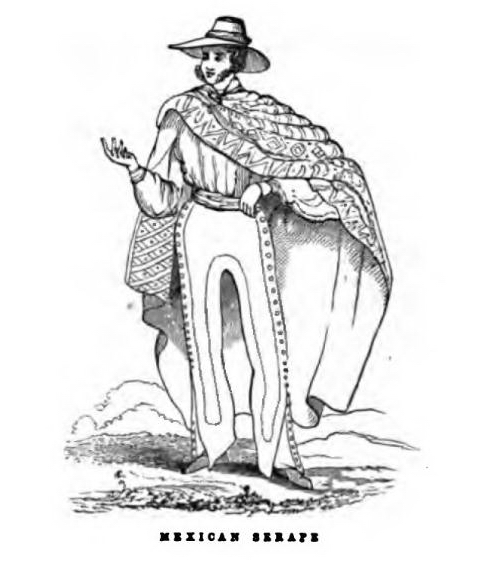Serape on:
[Wikipedia]
[Google]
[Amazon]

 The serape or jorongo is a long
The serape or jorongo is a long

 The serape or jorongo is a long
The serape or jorongo is a long blanket
A blanket is a swath of soft cloth large enough either to cover or to enfold most of the user's body and thick enough to keep the body warm by trapping radiant body heat that otherwise would be lost through convection.
Etymology
The term ...
-like shawl/cloak
A cloak is a type of loose garment worn over clothing, mostly but not always as outerwear for outdoor wear, serving the same purpose as an overcoat, protecting the wearer from the weather. It may form part of a uniform. Cloaks have been and ...
, often brightly colored and fringed at the ends, worn in Mexico
Mexico ( Spanish: México), officially the United Mexican States, is a country in the southern portion of North America. It is bordered to the north by the United States; to the south and west by the Pacific Ocean; to the southeast by Gua ...
, especially by men. The spelling of the word sarape (or zarape) is the accepted form in Mexico and in other Spanish-speaking countries. The term ''serape'' is for the rectangular woven blanket (no openings), though in more recent years it can also be used to refer to a very soft rectangular blanket with an opening in the middle for one's head, similar to a poncho
A poncho (; qu, punchu; arn, pontro; "blanket", "woolen fabric") is an outer garment designed to keep the body warm. A rain poncho is made from a watertight material designed to keep the body dry from the rain. Ponchos have been used by the ...
called ''gabán'', or ''jorongo'' in Mexico. Modern variations of some serapes are made with matching hoods for head covering. The length varies, but front and back normally reach knee height on an average person.
Available in various colors and design patterns, the typical colors of serapes from the highland regions are two-tone combinations of black, grey, brown, or tan depending on the natural color of the sheep flocks grown in the area, with large design patterns utilizing traditional indigenous motifs. On the other hand, the traditional serape as made in the Mexican state of Coahuila
Coahuila (), formally Coahuila de Zaragoza (), officially the Free and Sovereign State of Coahuila de Zaragoza ( es, Estado Libre y Soberano de Coahuila de Zaragoza), is one of the 32 states of Mexico.
Coahuila borders the Mexican states of Nu ...
in north-eastern Mexico near the city of Saltillo
Saltillo () is the capital and largest city of the northeastern Mexican state of Coahuila and is also the municipal seat of the municipality of the same name. Mexico City, Monterrey, and Saltillo are all connected by a major railroad and highw ...
often consists of a dark base color with bands of yellow, orange, red, blue, green, purple, or other bright colors. The ends are usually fringed.
History
The serape is thought to have its forebears in garments worn in the region near Chiautempan and Contla,Tlaxcala
Tlaxcala (; , ; from nah, Tlaxcallān ), officially the Free and Sovereign State of Tlaxcala ( es, Estado Libre y Soberano de Tlaxcala), is one of the 32 states which comprise the Federal Entities of Mexico. It is divided into 60 municipaliti ...
. During the Colonial period, it was taken to northern New Spain where it was adapted to the climate and the motifs changed. The city of Teocaltiche, Jalisco is strongly linked to the development of the serape, although it was widespread throughout the area then known as Nueva Vizcaya
Nueva Vizcaya, officially the Province of Nueva Vizcaya ( ilo, Probinsia ti Nueva Vizcaya; gad, Probinsia na Nueva Vizcaya; Pangasinan: ''Luyag/Probinsia na Nueva Vizcaya''; tl, Lalawigan ng Nueva Vizcaya ), is a landlocked province in the ...
.
Guatemalan serape
The serape is not a typical garment for theMaya
Maya may refer to:
Civilizations
* Maya peoples, of southern Mexico and northern Central America
** Maya civilization, the historical civilization of the Maya peoples
** Maya language, the languages of the Maya peoples
* Maya (Ethiopia), a popul ...
highland people, who wear different clothing in cold regions. The Guatemalan serape is an imitation of the Mexican serape with a Maya twist, and their production is intended for sales to foreigners or city dwellers who feel attracted to the garment. These serapes are sold through a broker, with the Mayan families, who depend mostly upon agricultural work, manufacturing small quantities for extra income. The brokers display the serapes at an incremental price at local markets or the sides of highland roads in improvised huts. The brokers are typically Maya. The appeal of the serape may be that they are made by Maya women on their traditional home looms, giving the serape a handmade look.
See also
* Huipil *Poncho
A poncho (; qu, punchu; arn, pontro; "blanket", "woolen fabric") is an outer garment designed to keep the body warm. A rain poncho is made from a watertight material designed to keep the body dry from the rain. Ponchos have been used by the ...
*Rebozo
A rebozo is a long flat garment, very similar to a shawl, worn mostly by women in Mexico. It can be worn in various ways, usually folded or wrapped around the head and/or upper body to shade from the sun, provide warmth and as an accessory to an ...
* Textiles of Mexico
* Tilmàtli
* Serape effect
References
Notes Bibliography * *External links
* {{Folk costume Robes and cloaks Mexican clothing